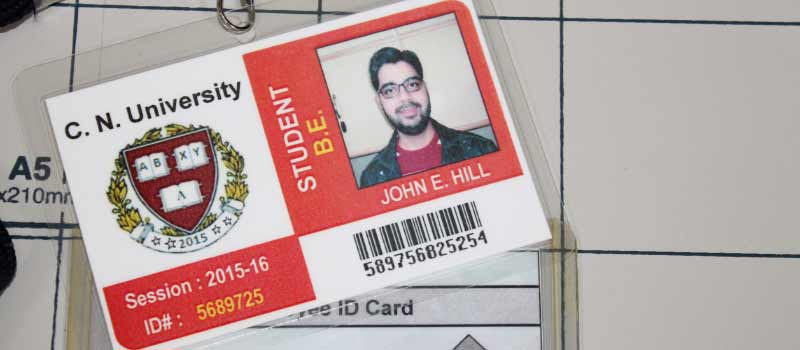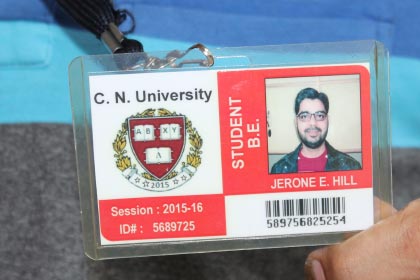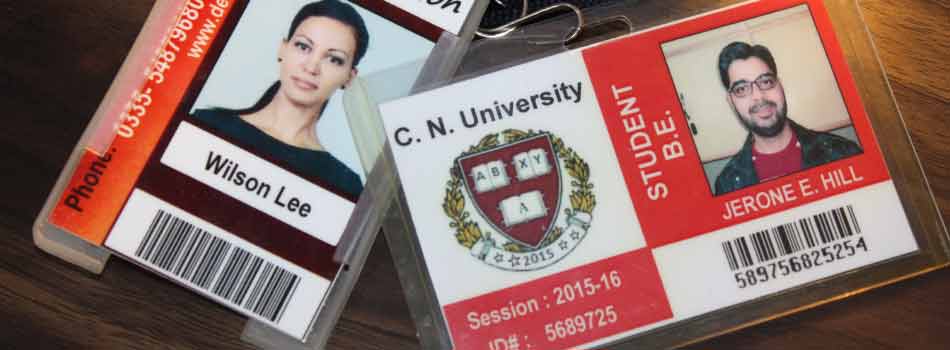A student ID card, also known as a student identification card, is an official document issued to students by their educational institution. It serves as proof of identity and affiliation with the institution. Student ID cards typically contain the student's name, photograph, signature, and a unique identification number.
By: Tech Solution
Published: 07/07/2023
Introduction of Student ID Card

The primary purpose of a student ID card is to verify the identity of the student. It provides a quick and easy way for school officials, faculty members, and other individuals to confirm that the person presenting the card is indeed a student of the institution.
A student ID card establishes the student's association with a specific educational institution. It indicates that the student is enrolled in that particular school, college, or university. The card may also display the institution's logo or name for visual identification.
Some institutions utilize student ID cards to track attendance. Students may be required to scan their cards when entering classrooms or other designated areas. This helps the institution monitor attendance records and identify students who may be absent without a valid reason.
Student ID cards often serve as library cards, allowing students to borrow books, access digital resources, and utilize other library services. The card may have a barcode or RFID chip that can be scanned at the library's circulation desk for easy identification and tracking of borrowed materials.
Many educational institutions use student ID cards to control access to their facilities. The card may have features such as magnetic stripes, barcodes, or RFID (Radio-Frequency Identification) chips that can be scanned or swiped to grant entry to buildings, libraries, laboratories, or other restricted areas on campus.
In certain cases, student ID cards can be linked to financial accounts provided by the institution. These accounts may be used for various purposes, such as making purchases at on-campus stores, dining facilities, or vending machines. The ID card functions as a means of payment or access to prepaid funds.
Student ID cards often provide access to discounts and benefits from partnering businesses or organizations. Students may be eligible for reduced fares on public transportation, discounts at retail stores, movie theaters, restaurants, or other establishments. These benefits are usually offered as a way to support students and enhance their overall experience.
🞛 It is important to note that the specific features and functions of a student ID card can vary depending on the educational institution and its policies. Some institutions may incorporate additional security measures, such as holograms or watermarks, to prevent counterfeiting or unauthorized use of the cards.
🞛 Conclusion: Overall, a student ID card is an essential document that establishes a student's identity, affiliation, and provides access to various services and facilities within their educational institution.
Benefits of Student ID Cards
-
1 Proof of Identity:
A student ID card serves as an official proof of identity, which can be used in various situations where identification is required. It provides confidence to individuals, such as school staff, exam supervisors, or employers, that the student is who they claim to be.
-
2 Access to Campus Facilities:
Many educational institutions use student ID cards for access control to campus facilities. Students can use their ID cards to enter libraries, computer labs, sports facilities, residence halls, and other restricted areas. This convenience eliminates the need for separate keys or access cards, enhancing campus security and efficiency.
-
3 Borrowing Privileges:
Student ID cards often serve as library cards, granting students borrowing privileges for books, academic resources, and other materials. With their ID cards, students can easily check out items from the library, conduct research, and access digital resources, supporting their academic endeavors.
-
4 Attendance Tracking:
Some institutions use student ID cards to track attendance in classes, lectures, or other academic activities. Students may be required to scan or swipe their cards to register their presence, which helps in monitoring attendance records accurately. This information can be useful for both students and educators to assess engagement and participation.
-

-
5 Discounts and Benefits:
Student ID cards often provide access to exclusive discounts and benefits from partnering businesses or organizations. Students can enjoy reduced prices on transportation, entertainment, retail purchases, restaurants, and more. These discounts are typically designed to support students financially and enhance their overall experience.
-
6 Financial Transactions:
Some student ID cards can be linked to financial accounts or prepaid funds provided by the institution. Students can use their ID cards as a means of payment at on-campus stores, dining facilities, vending machines, or for other services. This convenience eliminates the need to carry cash or credit cards and offers a secure way to manage expenses.
-
7 Student Services:
Student ID cards are often required for accessing various student services,such as counseling centers, health services, career development resources, or student organizations. These services are vital for students' well-being, personal growth, and involvement in campus life. The ID card serves as proof of eligibility to access these resources.
-
8 Security and Safety:
Student ID cards contribute to the overall security and safety of the educational institution. They help distinguish between students, faculty, and visitors, allowing security personnel to identify individuals easily. In emergency situations, such as lockdowns or evacuations, the ID card can assist in verifying students and ensuring their well-being.
-
9 Campus Events and Activities:
Student ID cards are often required for attending campus events, concerts, sports games, or other activities. The card may grant discounted or free entry to such events, encouraging student engagement and fostering a sense of community on campus.
-
10 Alumni Benefits:
Even after graduation, some educational institutions allow alumni to retain and use their student ID cards. This provides continued access to certain benefits, such as library services, discounts, or alumni networking events, facilitating ongoing connections with the institution and fellow graduates.
Summary: A student ID card offers numerous benefits, including proof of identity, access to campus facilities and resources, attendance tracking, discounts, and access to various student services. It enhances convenience, security, and engagement for students throughout their educational journey.
Key Features to Include in a Student ID Card Design
When designing a student ID card, there are several key features that should be included to ensure its effectiveness and functionality. These features serve various purposes, including identification, security, and access control. Here are the key features to consider:
-
🟆 Student's Information:
The student ID card should display essential information such as the student's full name, photograph, and unique identification number. This information helps in identifying the cardholder and differentiating them from others.
-
🟆 Institution's Logo and
Name:
Including the logo and name of the educational institution on the ID card enhances its credibility and establishes a visual connection to the school or university. This creates a sense of affiliation and authenticity.
-
🟆 Validity Period:
It's crucial to include the validity period of the ID card, indicating the academic year or the expiration date. This helps in ensuring that the card remains up to date and valid for a specific duration.
-
🟆 Barcode or QR Code:
Including a barcode or QR code on the ID card allows for efficient scanning and easy access to student information. It can be used for attendance tracking, library services, or entry to restricted areas.
-
🟆 Signature Area:
Providing a designated space for the student's signature serves as a form of personal verification and helps to prevent misuse of the ID card by unauthorized individuals.
-
🟆 Contact Information:
Displaying relevant contact details of the institution, such as the address, phone number, or website, allows others to easily reach out for verification or assistance when needed.
-
🟆 Access Control
Features:
If the institution requires access control to specific areas or facilities, incorporating technology such as magnetic stripes, RFID chips, or smart card functionality can enable secure entry and enhance the card's versatility.
-
🟆 Clear Design and
Layout:
The overall design of the ID card should be clear, legible, and visually appealing. Use a readable font for the text, ensure proper alignment, and maintain sufficient contrast between the background and the information displayed.
-
🟆 Lamination or
Protective Coating:
To increase the durability and longevity of the ID card, applying a lamination or protective coating is recommended. This helps protect the card from wear and tear, water damage, and fading.
-
🟆 Security Features:
To prevent forgery and unauthorized duplication, incorporating security features is essential. These may include holograms, UV printing, microprinting, or other anti-counterfeiting measures. Such features enhance the card's integrity and make it difficult to replicate.

Note: It's important to note that the specific requirements for a student ID card design may vary depending on the institution's policies, security needs, and available technology. Consulting with the institution's administration or design experts can provide further guidance and ensure compliance with their specific guidelines.
Standard Dimensions for a Student ID Card
The standard dimensions for a student ID card typically follow the size of a credit card. In this response, I will explain the standard dimensions of a student ID card in detail, providing information on the size, aspect ratio, and variations that may exist.
The standard size of a student ID card is generally 2.13 inches (54 mm) in width and 3.37 inches (85.6 mm) in height. These dimensions are similar to a standard credit card, allowing the ID card to fit conveniently in wallets or cardholders.
The aspect ratio of a student ID card refers to the proportional relationship between its width and height. For a standard ID card, the aspect ratio is 1.586:1. This means that the width is approximately 1.586 times the height.
While the dimensions mentioned above represent the general standard for student ID cards, it's important to note that there may be slight variations depending on the institution or country. Some institutions may have specific requirements or design preferences that deviate from the standard dimensions.
Larger Size Variations: In certain cases, student ID cards might be slightly larger than the standard dimensions. This can occur when additional information needs to be included, such as a barcode, magnetic stripe, or a larger photograph. However, even in these cases, the width and height proportions are generally maintained.
Smaller Size Variations: Occasionally, student ID cards may be smaller than the standard dimensions. This can happen when institutions prefer a more compact card or when the ID card serves a specific purpose that doesn't require a larger format.
Custom Shapes: While rectangular shapes are the most common, some institutions may opt for non-standard shapes for their ID cards. These can include rounded corners, elliptical shapes, or even custom die-cut designs. However, it's important to ensure that the custom shape still adheres to practical considerations, such as fitting in card readers or wallets.
When designing or printing student ID cards, it's crucial to consider practical aspects beyond just the dimensions. These factors include:
Bleed Area: The design of the ID card may require a bleed area, which extends the design beyond the final card dimensions. This ensures that there are no white borders when the card is cut to its final size.
Thickness: Student ID cards are typically printed on cardstock or PVC material, which gives them durability and a thickness similar to that of a credit card. The standard thickness for ID cards is around 0.03 inches (0.76 mm), but this may vary depending on the printing method and material used.
Card Orientation: Student ID cards are usually designed in a landscape orientation, with the width being greater than the height. However, some institutions may prefer a portrait orientation, with the height being greater than the width. It's important to clarify the desired orientation with the institution before proceeding with the design.
Compliance with Card Readers and Accessories: Ensure that the ID card design is compatible with card readers and accessories used within the institution. The dimensions should allow for easy insertion and removal from card readers, and any additional features, such as magnetic stripes or barcodes, should be correctly positioned and sized.
Summary: In summary, the standard dimensions for a student ID card are approximately 2.13 inches (54 mm) in width and 3.37 inches (85.6 mm) in height, with an aspect ratio of 1.586:1. However, variations may exist based on specific institutional requirements or preferences. It's essential to confirm the exact dimensions and design specifications with your educational institution before creating or printing your student ID card.